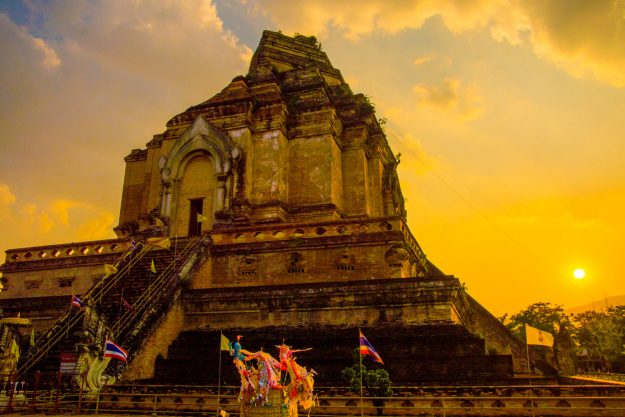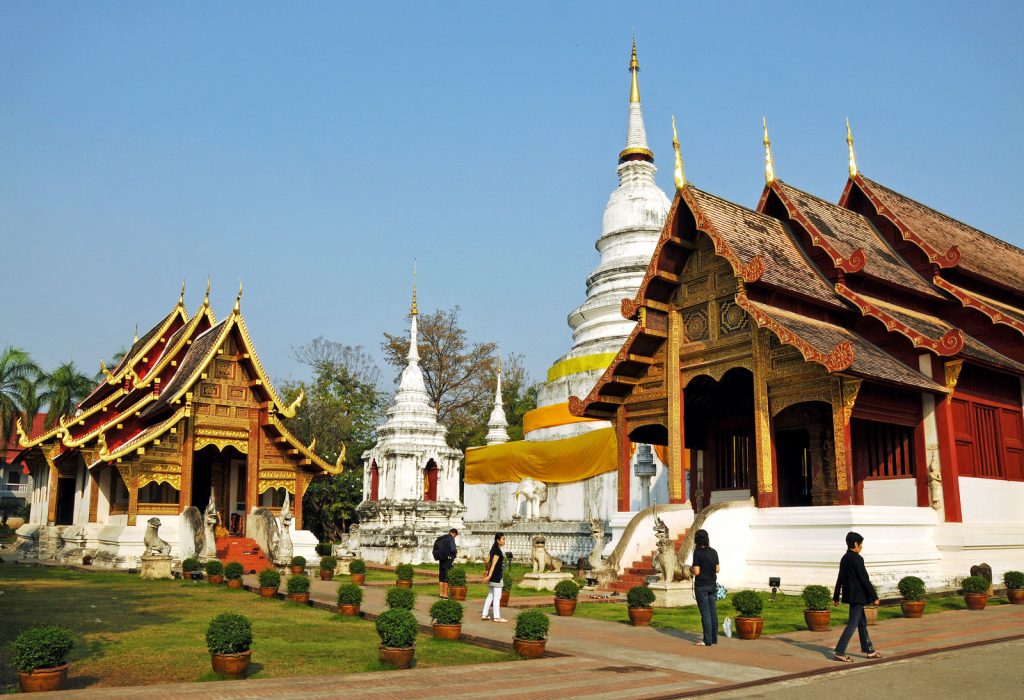“Nowadays, the temple seems like a business or company,” a student monk from Mahamakut Buddhist University (MBU), located at Wat Chedi Luang in Chiang Mai, Thailand, told me in 2016 when I asked his opinion about the new tourist entry fees that were emerging at that time.
“Why does my temple have to keep raising money for building projects? I have all I need in the temple—food, robes, shelter. Why do we need more when Buddhism teaches against greed?” another added.
The new fees were a reaction to a recent increase in tourism, a great deal of which came from an influx of Chinese tourists who flocked to Chiang Mai after the blockbuster 2012 Chinese comedy Lost in Thailand, which features some of the city temples.
The royal temple, Wat Phra Singh, had recently started charging 20 baht (60 cents USD) to enter the main worship hall, or vihara. Soon, Wat Suan Dok, which houses the MahaChulalongkorn Rajavidyalaya Buddhist University, would follow. At Wat Chedi Luang, the entry fee for tourists was set at 40 baht ($1.30).
Famous temples in the Old City of Bangkok had been charging tourist fees for years—$6 at Wat Phra Chetuphon, commonly referred to as Wat Pho and renowned for its 46 meter-long reclining Buddha statue; $16 at Wat Phra Kaew, home of the sacred Emerald Buddha statue and part of the Grand Place, which saw over 8 million visitors in 2016; and $8 at the Shwedagon Pagoda in Yangon, Myanmar, which had over 600,000 foreign visitors that year. But most Buddhist temples in Southeast Asia are free to enter, and Chiang Mai city temples had never charged before.
The Merit Economy
Traditionally, Buddhist temples operate via the economy of merit, in which the laity offer material goods to monks in exchange for spiritual rewards, including merit and the gift of Buddhist teachings. Merit is the positive force that one can accumulate or receive as a consequence of good actions, and it’s believed that this spiritual commodity can weaken the effect of past evils in the giver’s present life, as well as improve karmic trajectories for their future lives. The division of labor creates a system of mutual dependence, allowing monks to specialize in Buddhist study and practice while the laity practice generosity as donors.
With the rise of globalization and tourism, however, Buddhist monks increasingly encounter people who operate outside of their economy. The merit economy requires belief in karma and rebirth, along with an understanding of the Buddhist value of merit—something many tourists lack. Indeed, as author, Shin Buddhist priest, and professor Jeff Wilson described in an article for Tricycle last summer, many temples and meditation centers in North America, where the merit economy doesn’t have roots, have created new financial models, following what he calls “post-merit Buddhism.”

(The Trouble with) Tourist Fees
When tourism increased significantly in Chiang Mai, city temple leadership decided in 2016 that it was necessary to collect money from tourists, and they followed some of the larger temples in Bangkok by distinguishing between two separate spheres: the merit economy for Buddhists and fees for tourists who wish to observe and take part in Thai religion and culture.
While this clear separation made sense to many senior monks, many of the student monks in Chiang Mai’s Buddhist universities had reservations.
For the senior monks, charging tourists was a practical matter. Having a better understanding of temple budgets, they were primarily concerned with meeting financial needs and more readily accepted the idea of a tourist fee. Temples require staff to clean toilets, maintain landscaping, and provide security, and the senior monks described funds as scarce. The way they saw it, tourists took part in the wear and tear of the temples, so they should contribute to their upkeep. Some elder monks had traveled and seen the tourist temple fees in Bangkok, Vietnam, and China, and found the practice a viable solution, so long as the fee was not too expensive and the money was used to help the temples, not individual monks.
The student monks, on the other hand, held tight to the practices of the earlier Buddhist communities and were not as open to a dual economy. In their opinion, temples should not require any entrance fees, and budget deficits could be compensated in more appropriate ways—namely via donations. Money is dangerous and corrupting, some of these students said, and handling money could breed temptation. (In 2013, Thai officials issued a warrant for the arrest of monk Luang Pu Nenkham, who was later sentenced to 114 years in jail for running false donation schemes, whereby he used money for the temple to buy a private jet and luxury cars. In May 2018 five senior monks in Bangkok were arrested for temple fund embezzlement.)
Moreover, the forced collection of money, some argued, detracted from the temples’ unique atmospheres. The temples felt more like museums or other tourist attractions, rather than places to learn and practice Buddhism.
This difference of opinion between senior and student monks might seem counterintuitive because tourist fees are a modern adaptation, while the merit economy is the more traditional approach. But it wasn’t just about sticking to tradition for the student monks.
At Chiang Mai’s two Buddhist universities, many Thai, but also Cambodian, Burmese, Lao, and other South and Southeast Asian monks come to study Buddhism and secular subjects in English. Most of the student monks I discussed this issue with had moved to the city for the exclusive purpose of education. As one monk explained, “We are all very poor. This is our only chance to learn English.” Accordingly, many Thai and international monks were eager to converse with international visitors. These monks often participated in programs like Monk Chat, which allows tourists to learn about monastic life and Buddhism through informal conversations with monks. Student monks expressed concern that the tourist entrance fees would deter tourists from entering the temples and attending their programs.
A third group, containing a mix of senior and student monks, tried to find a balance so that the fees would not be necessary but tourists would still contribute. This group suggested teaching tourists to donate like Thai people. One senior monk proposed that the government collect visa fees from tourists and distribute this money to temples, relieving the temples from having to charge directly. One student thought big billboards explaining in English and Chinese why the temples need money, with pictures of their renovation projects, would motivate tourists to donate. Such compromises might appeal to Buddhist tourists who are familiar with the merit economy and would be put off by entrance fees.
The Price of the Pandemic
Whether tourists pay fees or learn to participate in the merit economy, the pandemic’s toll on tourism has left temples missing both the monetary gain that temple leaders value, and the cultural exchanges so important to the student monks. Thailand lost $50 billion in tourism last year with an 83 percent decrease in visitors from the 39.9 million visitors that broke records in 2019. Before the pandemic, Wat Pho would see anywhere from 6,000 to 10,000 tourists a day, with foreign tourists paying $6.40—a huge loss that will make it difficult for the temple to pay its monthly bills for much longer, the assistant abbot told Thai news outlet Prachachat in January.
As one Chiang Mai monk, a recent graduate from Laos, put it, “It’s like ten years ago here now, not like a tourist city anymore. It’s an interesting experience to see the city like this now: back to the basics and very peaceful. But I miss those young monks practicing English and having fun together, making conversation about Buddhism.”
Still, there’s optimism. “I try to accept my feelings and use the technique of meditation not to dwell,” a Monk Chat student advisor from Bangladesh told me. “But I think in the future, after COVID, people will want to learn from Monk Chat how to let go of their problems and get inner peace even more…I think after everything gets better, the tourists will have more effort, more intention to learn.”
Thank you for subscribing to Tricycle! As a nonprofit, we depend on readers like you to keep Buddhist teachings and practices widely available.
